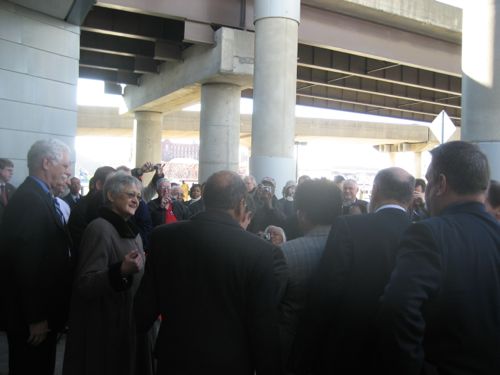Last week I rode the fairly new #99 Downtown Circulator bus with Metro employee Courtney Sloger. I had met Ms. Sloger a few weeks earlier as part of a panel with Dr. Todd Swanstrom of the University of Missouri St. Louis discussing transit for What’s Up Magazine. Sloger doesn’t own a car and uses transit herself. She is one of a couple of writers on Metro’s NextStop STL blog.
It was at this panel discussion I first heard of the #99 bus. I was so excited I wrote a post about it last month that included the route map:

When I agreed to ride the #99 with her I planned to use the opportunity to use my wheelchair to try the lift for entry/exit. The battery on my chair decided otherwise. With the chair no longer taking a charge I would need to drive my car to a point along the route. To simplify meeting Sloger I picked her up at Metro’s offices in Laclede’s Landing. I drove to 10th & Washington Ave where there was plenty of on-street parking on 10th. The time was around 4:30pm a week ago today. The bus stop was just around the corner on Washington Ave.
One of the amazing things about this route is the frequency of the buses, only 10 minutes. So we caught the next Westbound bus. I rode a bus in Seattle in March so I knew I could walk up the steps without issue. The buses being used are shorter than most in their fleet. This makes navigating downtown streets easier. Many seats still remained empty.
We headed West on Washington and turned left onto Tucker. Nobody got on or off along Tucker. At Spruce we turned right to head to the Civic Center Station with many bus routes, MetroLink, Greyhound and Amtrak. The #99 doesn’t board/unboard inside the bus section but along 14th street adjacent to the bus terminal. If you are passing through this point on the #99 be sure to get a transfer ticket when you board.
Resuming the ride when went in the direction we had just come from except now we were going East on Washington Ave. We turned right (South) on Broadway. We took Broadway South past Busch Stadium until we turned left at Poplar and left again on 4th. I didn’t set my timer but the entire round trip was much faster than I expected.
Along the way we talked about destinations nearby and how to market the route beyond the current ridership, mostly blue-collar transit dependent riders from my observation. I suggested the buses need a special look. While I preferred new low-floor buses Courtney Sloger thought a wrap works into the budget better. Agreed, just something to make the bus stand out from the others.
Many cities have transit lines to help you navigate from destination to destination. But just who are those more likely to take a ride on the #99?
Downtown residents and office workers seems an obvious answer. Tourists and visitors here for conventions? The wrap should include the words “downtown circulator” in big letters, I suggested. And a graphic of the route. Listing destinations reachable via the bus would help too.
When I visit a city I like to ride a bus or streetcar line to observe what is out there so I’ll know what to come back to on foot. But the current #99 misses one of the best parts of downtown, the two blocks of Washington Ave between Tucker and 14th. Visitors should see this. Granted if they exited at Tucker when the bus turn they’d be right there but I think going through it is better. I’d like to see the route modified to go up & down 14th rather than Tucker (12th). The problem is 14th is often closed at Chestnut for special events at Soldier’s Memorial. I guess on those days the bus could take Tucker.
For tourists they’d still need to know where they are going because destinations are not announced. Many places are close, but not obvious, such as Citygarden, Union Station, City Museum, and Culinaria. Someone might get into town late on a Saturday. After checking into their hotel on 4th they could take the #99 to grab a bite at a number of places such as the 12th Street Diner at Tucker & Washington Ave. While the diner is open 24 hours on the weekend, the bus line stops around midnight. Check the schedule for hours & directions.
I suggested Metro get hotel concierges to ride the route at least once. Downtown guides too.
As a helpful tool for downtown residents I suppose it depends upon where you live. If you are in the Edison Warehouse at 14th & Spruce it is am easy way to get you closer to stores like Macy’s, Culinaria and others. The steps into the bus, however, make bringing on purchases a challenge. For those of us West of 16th the line doesn’t help much. For people in the Pointe 400 apartments (old Pet building) on 4th Street it would be an excellent way to connect with restaurants and other destinations that are a good walk from your place.
I invite each of you when you are downtown next to ride the #99. See what you think. I like the possibilities it offers for the future. Certainly needs a special look. Most definitely needs low-floor vehicles to eliminate the steps.But it is a step in the right direction. Thanks Courtney Sloger for pushing me to ride the #99.
– Steve Patterson




